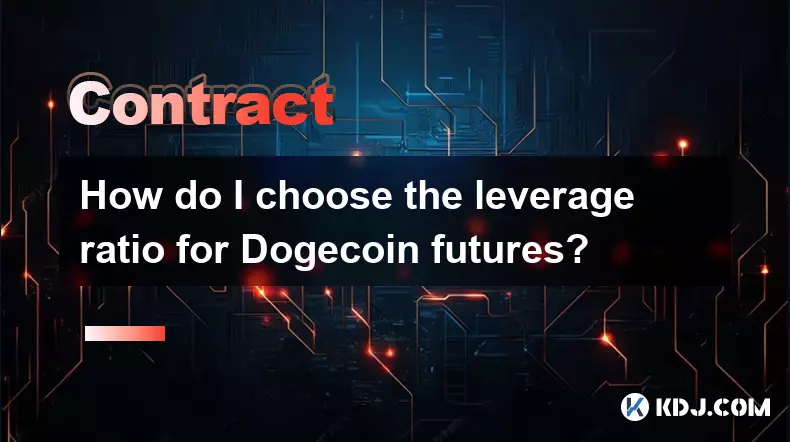-
 bitcoin
bitcoin $122025.899241 USD
-2.12% -
 ethereum
ethereum $4488.068729 USD
-4.11% -
 bnb
bnb $1315.348019 USD
8.65% -
 tether
tether $1.000457 USD
0.03% -
 xrp
xrp $2.875326 USD
-3.69% -
 solana
solana $222.043604 USD
-4.07% -
 usd-coin
usd-coin $0.999682 USD
0.00% -
 dogecoin
dogecoin $0.249887 USD
-5.62% -
 tron
tron $0.337379 USD
-2.59% -
 cardano
cardano $0.827763 USD
-5.06% -
 hyperliquid
hyperliquid $45.774531 USD
-2.43% -
 chainlink
chainlink $22.079309 USD
-5.87% -
 ethena-usde
ethena-usde $1.000156 USD
0.02% -
 sui
sui $3.482566 USD
-3.57% -
 stellar
stellar $0.386982 USD
-4.92%
How do I choose the leverage ratio for Dogecoin futures?
Leverage in Dogecoin futures amplifies both gains and risks, enabling large exposure with minimal capital—ideal for experienced traders who manage risk wisely.
Oct 03, 2025 at 11:37 am

Understanding Leverage in Dogecoin Futures Trading
1. Leverage allows traders to control a larger position using a smaller amount of capital. In Dogecoin futures, this means that even with minimal initial investment, one can gain exposure to substantial price movements. The leverage ratio determines how much the exchange amplifies your trading power. For example, 10x leverage lets you control $1,000 worth of DOGE with just $100 of margin.
2. Higher leverage increases both potential profits and risks. A 50x or 100x leverage may seem attractive due to the possibility of large returns from small price changes, but it also makes the position extremely sensitive to market fluctuations. Even a minor adverse move can trigger liquidation if the account equity drops below the maintenance margin level.
3. Different exchanges offer varying maximum leverage ratios for Dogecoin futures, typically ranging from 5x to 125x. Traders must assess their risk tolerance before selecting a ratio. Conservative investors often prefer lower leverage like 5x to 10x to avoid rapid liquidations during volatile periods.
4. Market conditions heavily influence the suitability of leverage levels. During times of high volatility—common in meme coins like Dogecoin—using excessive leverage could lead to abrupt losses. Monitoring order book depth, funding rates, and recent price swings helps determine an appropriate ratio.
5. Position size interacts directly with leverage. Increasing leverage while keeping position size constant raises exposure exponentially. It is critical to calculate the notional value of the trade and ensure it aligns with the overall portfolio strategy and stop-loss parameters.
Risk Management Strategies When Using Leverage
1. Setting predefined stop-loss orders is essential when trading leveraged Dogecoin futures. These orders automatically close positions at specified prices, limiting downside exposure. Without them, a sudden dump in DOGE price could wipe out the entire margin balance.
2. Diversifying across multiple assets reduces dependency on a single trade outcome. Allocating only a fraction of total capital to Dogecoin futures prevents overexposure, especially when using high leverage ratios.
3. Regularly monitoring open positions ensures timely responses to changing market dynamics. Automated alerts or trading bots can notify traders about key price levels or margin thresholds being approached.
4. Understanding the funding rate mechanism in perpetual futures contracts is crucial. High positive funding rates indicate long dominance, which might signal overheated bullish sentiment. Entering highly leveraged long positions under such conditions increases vulnerability to corrections.
5. Backtesting strategies using historical data provides insight into how different leverage levels perform under various scenarios. Simulating trades with realistic slippage and fees reveals whether a chosen ratio supports consistent profitability over time.
Choosing the Right Leverage Based on Trading Style
1. Day traders who execute multiple entries and exits within a single session often use moderate leverage between 10x and 25x. This range balances agility with manageable risk, allowing quick reactions without exposing the account to extreme volatility.
2. Scalpers relying on micro-movements may opt for higher leverage, such as 50x, to extract profit from tiny price differentials. However, they strictly limit position sizes and hold durations to mitigate liquidation threats.
3. Swing traders holding positions for days or weeks tend to favor lower leverage, usually below 10x. Their approach depends on broader trend analysis rather than short-term noise, making excessive amplification unnecessary and dangerous.
4. Arbitrageurs engaging in cross-exchange or spot-futures arbitrage typically avoid high leverage altogether. Since their gains are based on price convergence, stability and precision matter more than amplified exposure.
5. Newcomers should start with minimal leverage, ideally 1x to 5x, until they become familiar with futures mechanics. Gaining experience through paper trading or small live accounts builds confidence without risking significant capital.
Frequently Asked Questions
What happens when a Dogecoin futures position gets liquidated?When the mark price reaches the liquidation price, the exchange automatically closes the position to prevent further losses. The trader loses the margin allocated to that trade, and any remaining balance may be subject to a fee depending on the platform’s policy.
Can I change the leverage ratio after opening a Dogecoin futures position?Yes, most major exchanges allow adjusting leverage on existing positions, provided the modification doesn’t immediately trigger liquidation. Increasing leverage reduces the buffer against price moves, so caution is required.
Does higher leverage affect trading fees in Dogecoin futures?Leverage itself does not directly alter fee percentages, but higher leverage often correlates with larger notional values, which increase the absolute fee amount paid per trade. Fees are calculated based on contract size, not leverage level.
Is isolated or cross margin better for leveraged Dogecoin trading?Isolated margin restricts risk to a defined amount set by the trader, making it safer for aggressive leverage use. Cross margin uses the entire account balance as collateral, offering more flexibility but risking total account loss during sharp reversals.
Disclaimer:info@kdj.com
The information provided is not trading advice. kdj.com does not assume any responsibility for any investments made based on the information provided in this article. Cryptocurrencies are highly volatile and it is highly recommended that you invest with caution after thorough research!
If you believe that the content used on this website infringes your copyright, please contact us immediately (info@kdj.com) and we will delete it promptly.
- BlockDAG, DOGE, HYPE Sponsorship: Crypto Trends Shaping 2025
- 2025-10-01 00:25:13
- Deutsche Börse and Circle: A StableCoin Adoption Powerhouse in Europe
- 2025-10-01 00:25:13
- BlockDAG's Presale Buzz: Is It the Crypto to Watch in October 2025?
- 2025-10-01 00:30:13
- Bitcoin, Crypto, and IQ: When Genius Meets Digital Gold?
- 2025-10-01 00:30:13
- Stablecoins, American Innovation, and Wallet Tokens: The Next Frontier
- 2025-10-01 00:35:12
- NBU, Coins, and Crypto in Ukraine: A New Yorker's Take
- 2025-10-01 00:45:14
Related knowledge

What is the difference between futures and perpetual contracts for Bitcoin?
Oct 02,2025 at 11:54pm
Understanding Bitcoin Futures Contracts1. Bitcoin futures are derivative instruments that allow traders to speculate on the future price of Bitcoin at...

What is the best time to trade PEPE contracts?
Oct 03,2025 at 11:54am
Understanding PEPE Contract Volatility1. PEPE contracts exhibit extreme price fluctuations due to their meme-based nature and low market cap. Trading ...

What are the common mistakes to avoid with Bitcoincoin contracts?
Oct 03,2025 at 08:54am
Emerging Trends in the Cryptocurrency Market1. Decentralized finance (DeFi) platforms continue to expand their influence across the blockchain ecosyst...

What is the maintenance margin for Bitcoin contracts?
Oct 02,2025 at 01:36am
Decentralized Exchanges Gain Momentum in 20241. Decentralized exchanges (DEXs) have seen a significant rise in trading volume, surpassing centralized ...

How to use technical analysis for trading XRP contracts?
Oct 03,2025 at 01:18pm
Understanding Price Patterns in XRP Futures1. Identifying chart patterns such as triangles, head and shoulders, and double tops or bottoms can provide...

What does "longing" PEPE contracts mean?
Oct 03,2025 at 11:54pm
Understanding Decentralized Exchanges in the Crypto Ecosystem1. Decentralized exchanges (DEXs) operate without a central authority, allowing users to ...

What is the difference between futures and perpetual contracts for Bitcoin?
Oct 02,2025 at 11:54pm
Understanding Bitcoin Futures Contracts1. Bitcoin futures are derivative instruments that allow traders to speculate on the future price of Bitcoin at...

What is the best time to trade PEPE contracts?
Oct 03,2025 at 11:54am
Understanding PEPE Contract Volatility1. PEPE contracts exhibit extreme price fluctuations due to their meme-based nature and low market cap. Trading ...

What are the common mistakes to avoid with Bitcoincoin contracts?
Oct 03,2025 at 08:54am
Emerging Trends in the Cryptocurrency Market1. Decentralized finance (DeFi) platforms continue to expand their influence across the blockchain ecosyst...

What is the maintenance margin for Bitcoin contracts?
Oct 02,2025 at 01:36am
Decentralized Exchanges Gain Momentum in 20241. Decentralized exchanges (DEXs) have seen a significant rise in trading volume, surpassing centralized ...

How to use technical analysis for trading XRP contracts?
Oct 03,2025 at 01:18pm
Understanding Price Patterns in XRP Futures1. Identifying chart patterns such as triangles, head and shoulders, and double tops or bottoms can provide...

What does "longing" PEPE contracts mean?
Oct 03,2025 at 11:54pm
Understanding Decentralized Exchanges in the Crypto Ecosystem1. Decentralized exchanges (DEXs) operate without a central authority, allowing users to ...
See all articles










































































